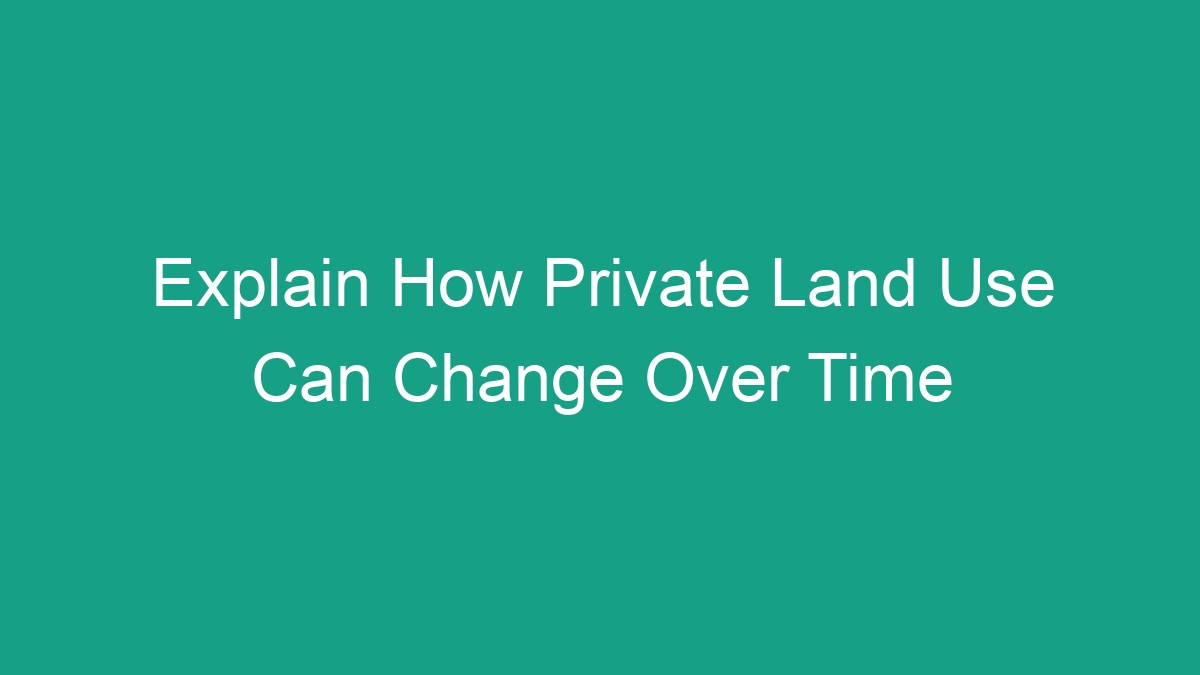
Introduction
Private land use refers to the way in which individuals or organizations utilize their land for various purposes such as residential, commercial, agricultural, industrial, or recreational activities. Over time, private land use can change in response to a range of factors including economic, social, environmental, and regulatory influences. In this article, we will explore the reasons behind the changing nature of private land use and how it impacts communities and the environment.
Factors Influencing Private Land Use Changes
Private land use can change due to a combination of internal and external factors. These factors can include:
- Economic Forces: Economic growth, market demand, and investment opportunities can drive changes in private land use. For example, a booming real estate market may encourage landowners to convert agricultural land into residential or commercial developments to capitalize on higher property values.
- Population Growth: Rapid population growth can result in increased demand for housing, infrastructure, and amenities, leading to the conversion of undeveloped land for urban or suburban expansion.
- Technological Advancements: Technological innovations in agriculture, construction, or energy production can prompt landowners to adopt new land use practices to improve efficiency and productivity.
- Environmental Considerations: Concerns about environmental conservation, biodiversity, and climate change may prompt landowners to transition towards more sustainable and eco-friendly land use practices such as reforestation, habitat restoration, or renewable energy production.
- Regulatory Changes: New zoning regulations, land use policies, and environmental laws can influence how landowners are permitted to use their land, potentially prompting changes in land use patterns to comply with new regulations.
Impacts of Changing Private Land Use
The changing nature of private land use can have a range of impacts on communities, the economy, and the environment. These impacts may include:
- Urban Sprawl: The conversion of rural or natural landscapes into urbanized areas can lead to increased traffic congestion, loss of natural habitat, and fragmented ecosystems.
- Infrastructure Pressures: Development and population growth can strain existing infrastructure such as transportation, utilities, and public services, potentially leading to increased costs and service disruptions.
- Environmental Degradation: Poorly managed land use can contribute to soil erosion, water pollution, deforestation, and loss of biodiversity, posing threats to ecosystems and natural resources.
- Property Values: Changes in land use can influence property values, with some locations experiencing appreciation due to desirable new developments or amenities, while others may see declines in value due to negative land use changes.
- Social Equity: Land use changes can impact the availability of affordable housing, access to public spaces, and the quality of living conditions for different socio-economic groups within a community.
Adapting to Changing Land Use
As private land use evolves over time, stakeholders must adapt to these changes in a proactive and strategic manner. This may involve:
- Land Use Planning: Communities can engage in comprehensive land use planning efforts to guide future development and preserve green spaces, cultural heritage, and natural resources.
- Smart Growth Strategies: Encouraging compact and mixed-use development, promoting walkable neighborhoods, and investing in public transit can help manage urban sprawl and mitigate negative impacts of land use changes.
- Conservation Efforts: Protecting critical ecosystems, establishing conservation easements, and incentivizing sustainable land use practices can help maintain ecological balance and protect natural habitats.
- Engaging Stakeholders: Involving residents, businesses, and community organizations in land use decision-making processes can foster a sense of ownership and responsibility for the long-term well-being of the local environment and economy.
- Promoting Sustainable Development: Encouraging energy-efficient building designs, green infrastructure, and renewable energy installations can help mitigate the environmental impacts of land use changes while promoting economic growth.
Conclusion
In conclusion, private land use is a dynamic and multifaceted aspect of human activities that has significant implications for communities, the economy, and the environment. Understanding the drivers of land use changes and their impacts is essential for ensuring the sustainable and equitable use of land resources. By promoting responsible land use planning, incorporating smart growth strategies, and fostering collaboration among stakeholders, we can adapt to changing land use patterns and create resilient, vibrant, and harmonious communities for future generations.
FAQs
How can I find out about zoning regulations that may affect my land use?
You can contact your local planning or zoning department to inquire about specific zoning regulations and land use restrictions that apply to your property. They can provide information on permitted land uses, setback requirements, building height limitations, and other related zoning ordinances.
What are some examples of sustainable land use practices?
Sustainable land use practices can include organic farming methods, reforestation projects, green building practices, habitat restoration initiatives, renewable energy installations, and sustainable forestry practices. These activities aim to minimize environmental impacts and promote the long-term health of ecosystems and natural resources.
How can I get involved in local land use planning efforts?
You can engage in local land use planning efforts by attending public meetings, participating in community workshops, contacting local planning agencies, or joining community-based organizations that focus on land use and conservation issues. Your input and involvement can help shape the future of land use in your community.



